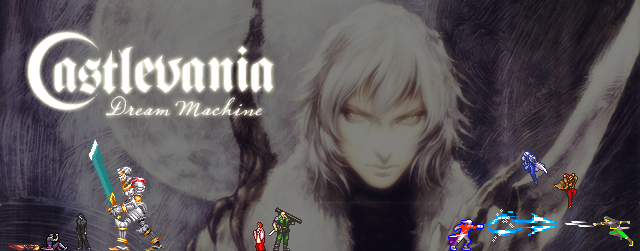 As the years go by, we expect everything to grow bigger and better. Video games are no exception. Each new generation gives developers more power to construct bigger worlds, prettier visuals, and more complex gameplay mechanics. Plenty of great series have followed this time-tested trend and succeeded greatly. Mario, Metroid, and Zelda have all benefited from more powerful and innovative technology, along with countless other series, but that doesn’t necessarily mean it is the only way to go. While everyone else was taking advantage of the latest and greatest hardware, Konami has kept the Castlevania series surprisingly old-school, and to great effect. Nowhere was this more true than on GBA.
As the years go by, we expect everything to grow bigger and better. Video games are no exception. Each new generation gives developers more power to construct bigger worlds, prettier visuals, and more complex gameplay mechanics. Plenty of great series have followed this time-tested trend and succeeded greatly. Mario, Metroid, and Zelda have all benefited from more powerful and innovative technology, along with countless other series, but that doesn’t necessarily mean it is the only way to go. While everyone else was taking advantage of the latest and greatest hardware, Konami has kept the Castlevania series surprisingly old-school, and to great effect. Nowhere was this more true than on GBA.
Now, in all fairness, I do have to acknowledge that Castlevania hasn’t completely avoided modernity. In fact, the most recent entry in the series, Lords of Shadow for Xbox 360 and PS3, was met quite positively as a good action adventure game in the same vein of Devil May Cry and God of War. When the series first tried to jump into the world of polygons on N64 the results weren’t nearly as impressive. At the time Castlevania 64 and its follow-up, Legacy of Darkness, were fairly ambitious titles that tried their best to bring the series’ mix of platforming and combat into a 3D world, but they have plenty of shortcomings that kept them well short of the system’s best offerings and time has done little to help their cause.
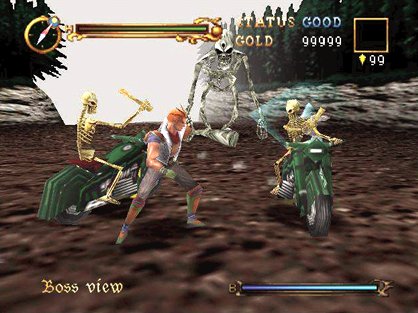
64 bits were not quite enough.
While the N64 offerings failed to live up to the expectations of such a well established and respected franchise, the series found its niche on PlayStation. Rather than try to play catch up with what Nintendo was doing with Zelda and Mario on N64, Castlevania pretty much embraced the ideas established by Metroid with Symphony of the Night. The side scrolling perspective was the same, the sprites were familiar, and the core gameplay mechanics were all but untouched; the only difference was that the world was now one massive, streaming environment and RPG like character progression and exploration mechanics were added to the mix. The mold might have been borrowed from Metroid, but Castlevania has embraced this style as its own for over a decade now.
Moving beyond the the PlayStation and N64 generation it was quite clear that most of the gaming world had pretty much moved beyond the constraints of 2D worlds, but the Castlevania fans had spoken, they didn’t want any of the nasty polygons getting in the way of their vampire slaying. In 2001 Konami took the franchise to the newest system the was the best for SNES style game design, Nintendo’s GBA, and that was a very good idea. Handhelds rarely serve as the primary platform for a major franchise, but GBA received three fully featured, amazingly well put together entries that were not only some of the best games on the system, but some of the best in the series.
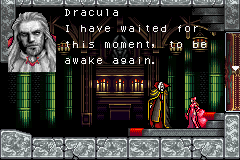 The whip wielding fun started the moment GBA hit store shelves on June 11, 2001. Castlevania: Circle of the Moon turned out to be something of a surprise gem; the series was well respected, but I think it came as a shock when it turned out to arguably be the best launch title. Like its PlayStation predecessor, Circle of the Moon featured a large castle filled with power-ups, hidden rooms, loot, and constantly evolving gameplay that made the platforming and combat equally satisfying. For fans of Symphony of the Night this was to be expected, but to new comers it turned out to be a most welcome surprise– including me, a total Castlevania newbie at the time. In keeping with series tradition, the game featured an amazing soundtrack and in a significant improvement over Symphony, had no horrendously bad voice acting! Topping off the whole experience was an incredible amount of replay value, because repeated play-throughs of the game unlocked new modes that drastically rebalanced character stats to favor magic, combat, sub weapons, or loot foraging.
The whip wielding fun started the moment GBA hit store shelves on June 11, 2001. Castlevania: Circle of the Moon turned out to be something of a surprise gem; the series was well respected, but I think it came as a shock when it turned out to arguably be the best launch title. Like its PlayStation predecessor, Circle of the Moon featured a large castle filled with power-ups, hidden rooms, loot, and constantly evolving gameplay that made the platforming and combat equally satisfying. For fans of Symphony of the Night this was to be expected, but to new comers it turned out to be a most welcome surprise– including me, a total Castlevania newbie at the time. In keeping with series tradition, the game featured an amazing soundtrack and in a significant improvement over Symphony, had no horrendously bad voice acting! Topping off the whole experience was an incredible amount of replay value, because repeated play-throughs of the game unlocked new modes that drastically rebalanced character stats to favor magic, combat, sub weapons, or loot foraging.
While the classic gameplay, rewarding yet balanced difficulty, amazing music, and ridiculous level of replayability made Circle of the Moon a great game, it did have its faults that surprisingly centered around its visuals. First and foremost among these problems was the darkness. The original GBA did not feature a back lit screen, so without a strong external lighting source, Circle of the Moon became incredibly hard to see. While the dark griminess is appropriate for a castle belonging to a horrible monster, it didn’t serve the gameplay very well. The other issue is that the sprite work didn’t quite live up to the series’ high standards; most characters were on the dull side and many animations were surprisingly lazy. Thankfully, the two follow-ups would remedy these problems in a major way.
Harmony of Dissonance came out the next year and immediately stood out as another high quality title well worth playing. The core gameplay remained almost untouched with the only major difference being a change to the magic system. Structurally, the game took a bit of a turn with the addition on a dual world system that had players warping between two versions of Dracula’s castle; and while this gave gamers more real estate to explore, the classic process of exploration and hunting down power ups remained untouched. The biggest change in the visuals as Harmony of Dissonance dramatically added a great deal more vividness to the color palette and dramatically improved the level of detail. Probably the most important part of this was the introduction of enemies constructed from multiple sprites; this allowed for larger bosses and more grandiose animations as every piece of the character art could be manipulated individually. Strangely enough this didn’t necessarily make for a better game.
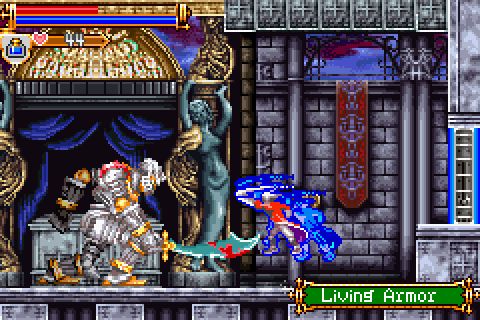
Yes, he’s glowing. No, he won’t stop.
Maybe it’s just me, but Harmony of Dissonance didn’t quite live up to its predecessor. Yes, the game was brighter, but I daresay it was too much; the main character, Juste Belmont, was constantly surrounded by a bright blue outline and many enemies received the same treatment. Also, the few gameplay tweaks, most notably the less complicated magic system, made the overall experience feel less robust than Circle of the Moon. Finally, the post-game features didn’t offer the same replay value, as they were limited to only one additional character and a boss rush mode. Harmony of Dissonance was still a great game, but it didn’t quite achieve its true potential.
Apparently Konami felt the same, because when it came time to craft GBA’s final Castlevania adventure, they poured every ounce of their being into developing an amazing title. Aria of Sorrow took less than a year to reach the market, thanks largely to overlapped development time with Harmony of Dissonance, but managed to be a surprisingly different experience. First of all, the Victorian setting and art style were swapped out for a near-future time frame and character designs in keeping with contemporary anime trends, a move that could have made the game feel more generic but ultimately just made it stand out more within the franchise. To differentiate the gameplay from the other GBA iterations, Aria of Sorrow brought back the broader weapon selection introduced in Symphony of the Night, which did away with the whip in favor of an assortment of swords, spears, and axes. But the big game-changer was the inclusion of collectible souls, magical attacks taken from defeated enemies that allowed for an unprecedented level of customization. Add in visuals that were a notch above Harmony of Dissonance without being nearly as garish and a few extra post-game offerings, and you have what is easily the best Castlevania on GBA.
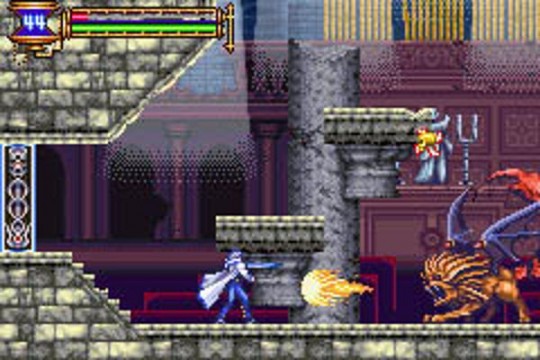
Welcome home, Castlevania. It’s been a while.
Okay, there is a bit more to this story and that is– well– the story. Most Castlevania games featured vampire hunters, generally members of the Belmont clan, trying stop Dracula’s resurrection. Symphony of the Night broke this mode by featuring Dracula’s own son as the star and Aria of Sorrow also adds a twist to the formula. While the return of Dracula once again sets up the story, the hero in Aria of Sorrow, Soma Cruz, is just an innocent bystander caught in the crossfire. Or at least, that appears to be the case, until a surprise reveal puts everything into a brand new perspective. Ultimately the story does play second fiddle to the stunning gameplay, but Konami still deserves credit for avoiding the cookie cutter and giving the story just as much fresh air as the gameplay mechanics.
The Castlevania franchise has long held a place in the very foundation of gaming with a venerable history that goes back decades and a legion of fans that numbers in the millions. The first few titles helped define side scrolling action, the music is acknowledged as some of the industry’s best, and ever since Symphony of the Night, Konami’s created a weird little genre that many have come to lovingly refer to as Metroidvania. This is an amazing history that just about any developer would envy, but the fact that the last of decade of Castlevania has primarily revolved around GBA and DS is a bit of a rarity, with the only other exception probably being Pokémon– and those are some strange bedfellows. Of course, Castlevania has had a couple PS2 offerings, but gamers will always remember how the series set the standard for sprite-based games with every new entry on Nintendo’s handhelds. Once the history of video games finally gets written, Castlevania will definitely get its own section– and at least one of those chapters will be one the amazing things the series accomplished on GBA.




 ShareThis
ShareThis






